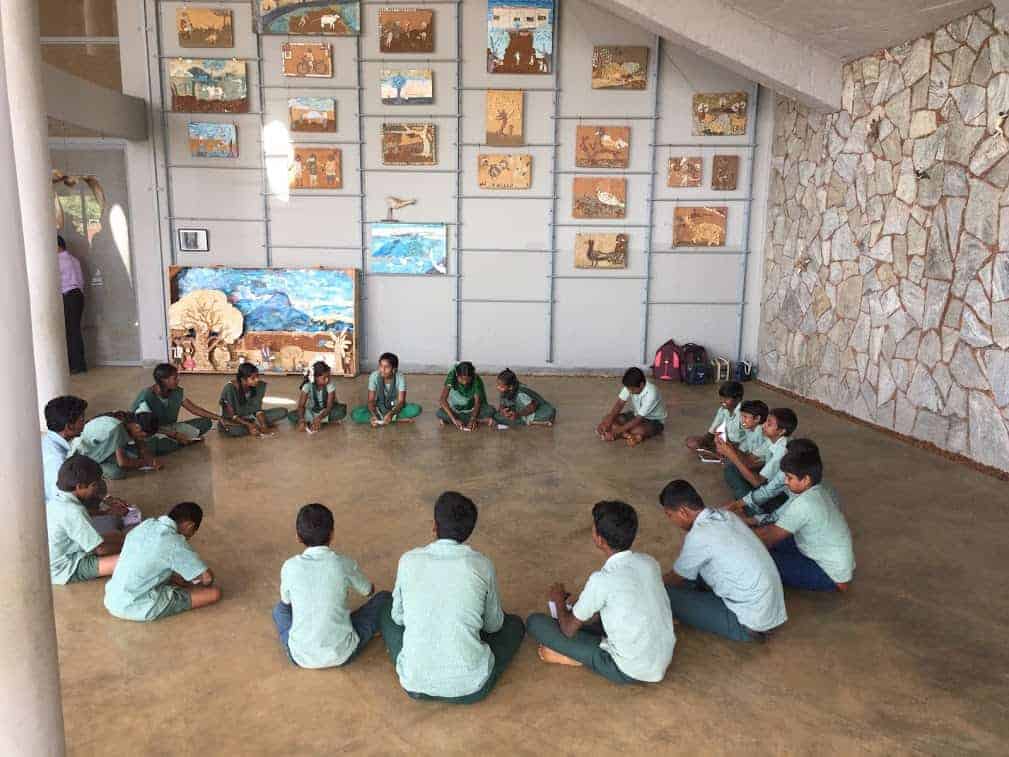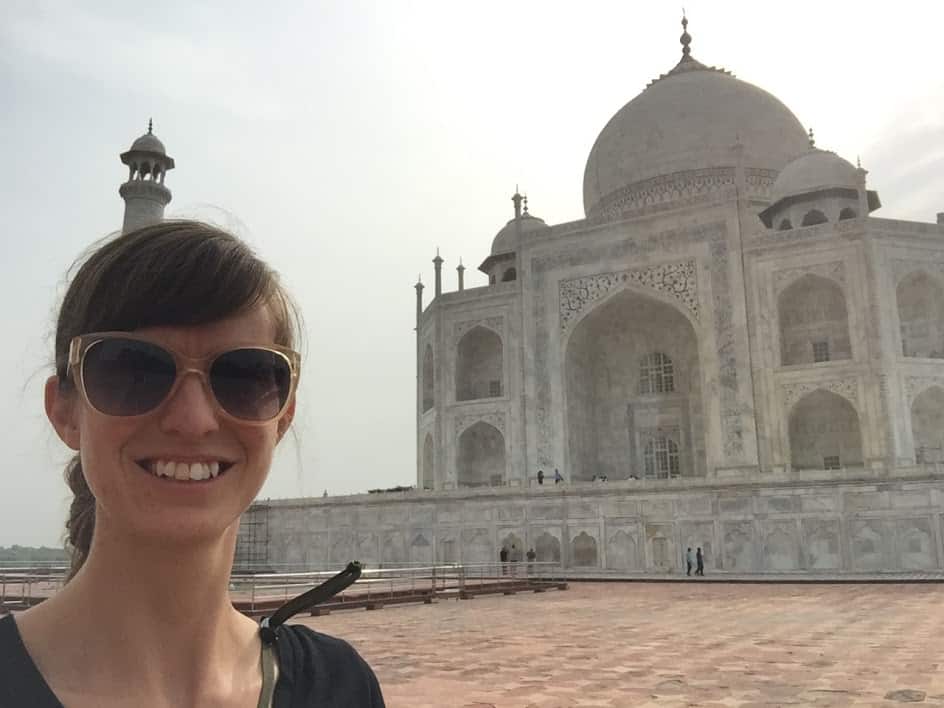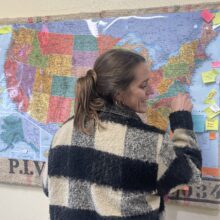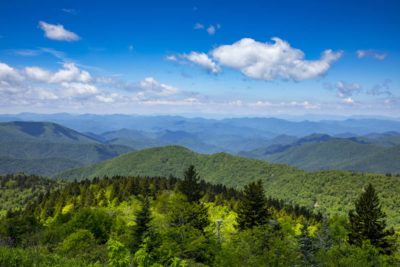

In August 2017, Sallie Senseney, a science teacher from Yancey County, and a group of 10 North Carolina education leaders traveled to India to learn about the country’s education system, economic development, and STEM education thanks to the Burroughs Wellcome Fund (BWF) in partnership Go Global NC. Senseney is a recent winner of the BWF Career Awards for Science and Mathematics Teachers which will provide $175,000 over five-years for things like equipment and supplies, professional development, and more.
We sat down with Senseney to see what lasting impressions the trip to India made on her teaching style, classroom, and more. See our insightful conversation below, edited for length and clarity.


Parker: You went to Mountain Heritage High School. How important do you think it is for students to see an educator who graduated from here and is interested in seeing the world?
Senseney: I think it’s really important because there are actually a lot of people who teach here who went to school here. A lot of people are from this community, all their family is from here. So this is their home and a lot of people don’t leave, and the ones that do leave to go to college often come back. Especially for teaching, there are jobs, but other kind of careers, there aren’t so many up here.
I think that something I and a few other teachers here have done is really try to open up a window to the world for the kids. Even when I just talk to them about places I’ve traveled. I talked to them about how I graduated a semester early and traveled and then I took a year off from college and I traveled, and then I went on this trip to India. Bringing up, “Oh yeah I’ve been there,” helps students realize, “Oh, it’s not that scary in other places.”
And also, that kind of helps me make connections with students. I have a lot of students right now in one of my classes whose families are from Mexico. And most of the students were born here, and some of them have never been to Mexico, but some of them go back to visit family. When I graduated from high school, I traveled in Guatemala and Honduras. One day, at lunch, they were just in here and I pulled up Google Earth, and I had them show me the towns where their families are from and asked them questions. They were really interested in sharing with me, and I think me having a starting point of travel gave me a launching point to talk to them. And I think that even places I haven’t traveled, if there’s some connection I can make to the content to pull up a map and just say, “Well, where are we even talking about?” I have students who don’t know that the coast of North Carolina is the Atlantic Ocean, and I think it’s hard to remember that kind of stuff if you don’t have a connection.
Parker: What was the original mission, in your words, in traveling to India almost two years ago with Go Global NC?
Senseney: So I think the mission of the trip was to examine how another country approaches science and other STEM fields. I was looking at it from the science angle, because that’s my discipline, and how the education system approaches it, but also just the culture around STEM and STEM careers. I was trying to see what are common best practices that are used pretty much anywhere, what are things that the schools in India are doing better than we’re doing here, and then also just some time to talk to teachers. Teachers who were on the trip, but also teachers we met there. It’s always fun to talk shop with other teachers.
Parker: What stood out to you most in the classrooms in India?
Senseney: We saw a bunch of really different kinds of classrooms on that trip. The ones that really stick out to me were classes of 60 or 80 students in a classroom with one or maybe two teachers. And just thinking about how much of a challenge that would be, and to see teachers who were still using stuff like group work and lab activities and they weren’t just lecturing, even though they had that many kids. And so that made a big impression on me and just how the students and families we talked to seemed so thankful for the opportunity to have education. That was kind of a different perspective.
It’s not like, “Oh, you’re making me do this, or like ugh, I have to do this.” The kids, they see the value in it, because they see it’s the way to a good job. And I think because the society is still so stratified, having really intense poverty is a total option for a lot of those kids. And of course, it is here too, but it’s way more intense there. So they know that they’re competing with this huge population for jobs. And they know they need to learn to get a better job.
The other thing that was super impressive to me was this particular seventh grade grade science class. It was an all girls classroom. I think there were 60 students. And it was one of the Teach for India classrooms. So the teachers were in Teach for India, and they had been with this group of students, they follow them for a couple grade levels. The students were standing up and talking about Newton’s laws in English which was their third language. They were so eloquent.
That inspired me to think I need to give my students practice talking in front of people and expressing themselves clearly. These students were 12 years old and they were able to do it better than a lot of adults that I know. They were coming from a very poor neighborhood. This wasn’t a fancy school with privileged kids, they were coming straight out of poverty, and they were learning these skills. That’s cool.
Parker: What surprised you most about what you saw?
Senseney: I think the thing that surprised me, in general on the whole trip, but also in classes, was the huge range of everything. In general, the contrast between the cities, the suburbs, and the rural areas was so stark. The difference between how poor the poor areas were, and how wealthy the wealthy areas were — it was just this huge, huge difference, and it could be in a very small geographic area.
We saw classrooms that were very rote instruction, we saw classes that were huge classes where teachers were trying all this really creative stuff, even though they had huge classes. Then this wasn’t really a classroom, but we went to this place called Agastya International which is a private science center. It’s a nonprofit foundation, and it’s right in the middle of three or four really rural states. They have all these super cool things like physics demonstrations and a scale model of the solar system, and you can watch everything rotate on the roof of the ceiling of this really big building. The kids from public schools come there, the teachers bring their kids, and while the students are going through all these lessons, the teachers are getting professional development on how to do that kind of instruction in their own setting. That was really cool. It wasn’t a typical classroom, but it was a way for public school kids to get that opportunity.
Parker: Has the trip changed the way you teach?
Senseney: I think that it didn’t have a, “I’m totally redoing everything I’m doing” kind of impact, but I have my students do way more short little presentations now, because I’m realizing they need practice standing up in front of people and talking. Also, even just figuring out like, as a group, okay, there are three of us who are in charge of what. They just need a lot of practice with that kind of stuff. I also use pictures from our trip when I teach about population growth because that’s a very direct tie in with the biology curriculum.
I think the biggest impact that the trip had on me was connecting me to opportunities that I have here that I didn’t really realize. Michelle Ellis was on the trip, and she’s a CASMT (Career Award for Science and Mathematics Teacher) awardee. I had seen emails about the CASMT, and I thought you’re supposed to do that the end of your career. It’s called the Career Award.
We are on the back of this bus on a really bumpy road, I think we might have been going to Agastya International actually. I was talking to her and Elizabeth Cunningham, who’s also on the trip, and they encouraged me to apply for it. It had never crossed my mind that I should apply for it right now. They really encouraged me, and then they both read my application and helped me edit. That’s been the biggest game changer. It’s about to, for the next five years, have a pretty big impact on this district.
Parker: In the article you did with WNC magazine, you said that in class you talk about population growth and how it impacts the environment and how cultural factors impact access to health care and family planning. Did you have any takeaways from the trip in terms of those things?
Senseney: We visited a school in a neighborhood that there’s physically no more space to build more schools. The population of school-aged children is so big that they’re having to use one building for two schools. It’s all girls in the morning and all boys in the afternoon. And there are, I think, 5,000 girls and 5,000 boys, and it’s from around a mile radius or something like that.
So the density of that neighborhood was so clear. There’s actually not enough rooms, there’s not enough space to build more schools, and there’s not enough schools to house all the kids who were here. So that was staggering to me.
I think that learning a little bit about the history of India and how it’s a relatively young democracy, they didn’t get independence all that long ago from Britain, and they’re having to do all of this reestablishing their own government, while also dealing with like this huge population boom at the same time. Schools are overcrowded, but also, the landfills are actually full. They’re having to burn the trash to make room in the landfill or the sewer system hasn’t been expanded fast enough and so there’s open sewage ditches.
I’m able to show that kind of thing to my students. It takes some work for them not to look at it with a really judgmental view of, “Well, why can’t they just get it together?” So then you start talking about, well, “What was the United States like 50 years after our independence?” and “What are all the pressures that they’re having to deal with?” and “How do you invest in all this infrastructure, while also [keeping] your economy growing?”
I think it is pretty intense, and then I teach population growth with environmental issues. So you talk about those two things together. You can talk about air quality, and how schools are actually closed in New Delhi frequently because of air quality problems and stuff like that. So we got to like see some of those issues firsthand.
Then we also got to meet with people who are trying to create solutions. Some nonprofits are trying to get solar panels out to places where the electrical grid does not even exist. One cool program is increasing enrollment in schools in rural areas by giving each student a battery operated light that they could take home, because a lot of their families didn’t have electricity. They had to bring them back to school to charge the battery. So they saw school enrollment go way up, and attendance go way up, because that made the families have buy-in, like, “Oh there is a reason for you to go to school now.” And in the meantime, the kids get fed and they learn at the same time.
Parker: It’s been two years since your trip. What has been the longest lasting impact for you?
Senseney: I think that the longest lasting impact has been how the whole country of India seems to be pretty behind STEM education, maybe to an extreme. That’s what everybody wants their kids be — an engineer or a doctor. I don’t necessarily think that going so far to that extreme is good, but I hadn’t really thought about myself as a player in a national movement or even a state movement to provide students with opportunities to learn STEM disciplines.
I hadn’t thought about my role that way before, but I realized that, especially in a rural place like this, we don’t have universities nearby, we don’t have companies nearby that are have anything related to STEM. So for our kids to get those opportunities, it has to come through the schools. So it’s not just earth science and biology and physical science and chemistry they need to learn, but they need to have opportunities to practice inventing things, and they need the opportunities to go other places and see what people are doing. That was part of my inspiration for applying for the CASMT, thinking: How could I use that resource to open up more opportunities for kids who live here?
If you never have the experience, or you never see what the options are, how are you supposed to know that’s a road you can go down? I went to high school here, but my dad was a biology teacher, and he had traveled. And my parents had diverse experiences and so I kind of got that through them instead of through schools. Even still, when I got to college, I kind of felt like, “Oh, other people here have had opportunities that I did not [outside of the classroom].” I think starting to think of myself as a player in a bigger movement and then learning about this resource I could use to actually try to bring some of that to our students — I think that has been a longest lasting impact so far, and I think it’ll continue.
Editor’s note: The Burroughs Wellcome Fund supports the work of EducationNC.


